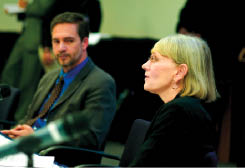Can You Back That Up?
Employers are starved for employees who can reason and argue based on evidence. Deanna Kuhn has developed a curriculum to teach those skills
Employers are starved for employees who can reason and argue based on evidence. Deanna Kuhn has developed a curriculum to teach those skills
by Suzanne Guillette
Teenagers are good at argumentative reasoning, as any parent knows, but they don’t always prove it in the classroom—or later on, in their jobs.
Enter Deanna Kuhn, Professor of Psychology and Education. She has designed “Inquiry and Argumentation,” a multi-year curriculum that teaches students to support their arguments with substantive, well-considered reasons.
“Most real world phenomena have multiple causes, so it’s important for students to develop multi-variable thinking,” says Kuhn, who first outlined her ideas in her book Education for Thinking (Harvard University Press, 2005). “This is the focus we need for middle and high school students for the 21st century.”
Funded by a three-year grant from the Institute of Educational Sciences, Kuhn’s curriculum was launched in 2007 at Columbia Secondary School (CSS), which opened the same year.
“Deanna has always had a passion for philosophy, which she sees as part of being an ethical educator,” says CSS Principal Jose Maldonado had worked with Kuhn on his thesis at TC.
Kuhn’s curriculum was partly inspired by the new K–12 Common Standards, which many states are adopting. “Argumentative reasoning” is an identified skill within the standards, though its precise nature is not specified.
At CSS, the inquiry and argumentation program is overseen by Kuhn and led by a group of her current TC doctoral students. Sixth graders debate relevant questions in their lives, such as “Should a misbehaving student be expelled?” Seventh graders address a broader scope of issues, such as, “Is the one child policy in China unethical?”, with an increased emphasis on supporting evidence. Eighth graders return to questions of personal relevance, more broadly framed—for example, “What makes a ‘good’ adolescence?”
A typical course cycle lasts 12 sessions. Students generate ideas and pair up to argue across classrooms via chat room software, which keeps arguments focused and generates a record that becomes the basis for reflective papers. Next, pairs who argued the same viewpoint have “showdowns” in front of the class with their opposite numbers. The group then de-briefs and chooses “winners” before each student writes a final-position essay.
“In the beginning, they were hesitant to voice disagreement,” says Kuhn’s longest-serving intern, study co-author Amanda Crowell, of the high school freshmen who took the curriculum throughout middle school. “Now, when they argue, it’s on point, direct and respectful.” True, they are more apt to challenge teachers’ opinions, too, but “we can’t really complain about that,” says Crowell with a smile.
Now Kuhn’s model is spreading. Spurred by Dominican President Leonel Fernández’s 2008 visit to CSS, schools in the Dominican Republic are replicating Kuhn’s curriculum. After a year, “the way students express themselves on any topic and the secure way that they address their classmates is completely different,” says Sarah Espaillat, the lead teacher implementing the curriculum at the Instituto Technológico de Santo Domingo.
In New York, Say Yes to Education, a non-profit committed to increasing graduation rates of urban youth, initiated a modified version of Kuhn’s course in its summer program this past July.
“It’s fun working with computers,” said Katie, a sixth grader in the Say Yes summer camp in July, who was debating classmates about whether students who fail a year of school should proceed to the next grade if they work with a tutor over the summer. “Plus, you don’t know who you’re talking to, so there’s mystery.”
Plus the approach she was taking might some day render the question she was debating, well, academic.
Published Wednesday, Dec. 15, 2010
